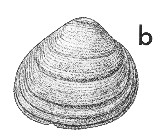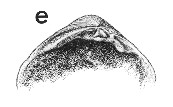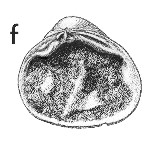
Revised descriptions of New Zealand Cenozoic Mollusca from Beu and Maxwell (1990)

 | Revised descriptions of New Zealand Cenozoic Mollusca from Beu and Maxwell (1990) | 
|
  (Pl. 35b): GS5626, C46/f9594, Birch's Mill shell lens, cliffs behind Te Waewae Bay, Southland, early Opoitian (GNS) |
  (Pl. 35e): GS5626, C46/f9594, Birch's Mill shell lens, cliffs behind Te Waewae Bay, Southland, early Opoitian (GNS) |
  (Pl. 35f): GS5626, C46/f9594, Birch's Mill shell lens, cliffs behind Te Waewae Bay, Southland, early Opoitian (GNS) |
Beu & Maxwell (1990): Chapter 14; p. 286; pl. 35 b,e,f.
Synonymy: Corbula dubia Hutton 1873b, p. 18 (not of Deshayes, 1837); Mactra chrydaea Suter 1911, p. 596; Maorimactra chrydaea, Beu & Maxwell 1990, p. 286, pl. 35b, e, f.
Classification: Mactridae: Mactrinae
Description: Small for family (17-28 mm long), relatively high and very inflated and evenly convex for genus, thick and solid; exterior smooth except for weak growth ridges; umbo at anterior third. Hinge relatively narrow, with a very small, central, narrowly triangular resilifer in each valve; right valve with a pair of diverging, inverted-v-shaped, very small, but thick cardinal teeth immediately in front of resilifer, and a pair of heavy, short, smooth lateral teeth on each side of hinge; left valve with a very short cardinal lamella in front of resilifer, and a single heavy, short, smooth lateral tooth on each side of hinge. Both valves also have a "mactroid" ridge and spur below umbo, above-top of resilifer. Adductor scars small, subcircular, very close to anterior and posterior margins; pallial sinus small, semicircular, equal in size to and just below posterior adductor scar.
Comparison: Mactra (Maorimactra) chrydaea is much more rounded, inflated, and solid than other Mactra (Maorimactra) species. M. acuminella (? Waitakian-Altonian) (Pl. 19c,h) is smaller, more elongate and more thin-shelled, with a prominent umbonal-posterior ridge. M. ordinaria (mid-Castlecliffian-Recent), the type species, is smaller, much less inflated, and with its umbo nearer the anterior end. M. marwicki Beu, 2006 (Nukumaruan) is similar in size to M. ordinaria, but more elongate, with a narrowly rounded posterior end. M. carteri Beu, 2006 (early Castlecliffian) is a large, weakly inflated, distinctive species in Wanganui basin with a thinner shell than M. chrydaea. A distinction between Mactra (sensu stricto) and Maorimactra is not obvious, and Beu (2006) reduced Maorimactra to a subgenus for the lineage of small New Zealand Mactra species culminating in M. ordinaria.
Distribution: Kapitean-Waipipian; New River, south of Greymouth, Westland, Opoitian or Waipipian (type of Corbula dubia, preoccupied; illustrated by Boreham 1965, pl. 20, fig. 4); "North Island main trunk [railway] line, between Mataroa and Turanga-a-rere", i.e., central North Island near Tongariro National Park, Opoitian or Waipipian (types of Mactra chrydaea). Common enough in shallow-water, soft bottom facies of Kapitean to Waipipian age throughout New Zealand to form a useful biostratigraphic zone indicator, particularly in the Tongariro-Waiouru area (central North Island), in the Blue Bottom Group in Westland, and in Southland; superabundant and well preserved in the Birch's Mill shell lens (Opoitian) at Te Waewae Bay, Southland.
Cite this publication as: "A.G. Beu and J.I. Raine (2009). Revised
descriptions of New Zealand Cenozoic Mollusca from Beu and Maxwell (1990). GNS
Science miscellaneous series no. 27."
© GNS Science, 2009
ISBN
978-0-478-19705-1
ISSN 1177-2441
(Included with a PDF facsimile file
copy of New Zealand Geological Survey Paleontological Bulletin 58 in CD version
from: Publications Officer, GNS Science, P.O. Box 30368 Lower Hutt, New
Zealand)